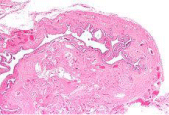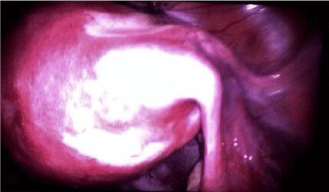
Case Report
Austin J Obstet Gynecol. 2015;2(3): 1044.
Salpingitis Isthmica Nodosa; Two Case Reports and Review of the Literature
Emine Demirel¹*, Sefa Kelekci¹ and Mustafa Sengul¹
¹Department of Obstetrics and Gynecology, İzmir KatipCelebi University, School of Medicine, Turkey
*Corresponding author: Demirel E, Department of Obstetrics and Gynecology, İzmir Katip Celebi University, Turkey
Received: June 16, 2015; Accepted: June 24, 2015; Published: June 30, 2015
Abstract
Background: Salpingitis isthmica nodosa (SIN) is a condition of nodular thickening of the proximal Fallopian tube. The purpose of this case report is define that the relationship between SIN and subfertility.
Case: We detected incidentally bilateral proximal tubal salpingitis isthmica nodosa 34 and 36-year-old two women who underwent laparoscopy because of subfertility.
Conclusion: Salpingitis Isthmica Nodosa is significantly associated with the recurrent ectopic pregnancies and subfertility.
Keywords: Ectopic pregnancy; Salpingitis isthmica nodosa; Subfertility; Tubal disease
Introduction
Salpingitis isthmica nodosa, also known as diverticulosis of the Fallopian tube, is nodular thickening of the narrow part of the uterine tube, due to inflammation. SIN is associated with subfertility and ectopic pregnancy [1], and may present as either. It is characterized by nodular thickening of the tunica muscular is of the isthmic portion of the Fallopian tube. In severe cases, it leads to complete obliteration of the tubal lumen. It is bilateral in about 85% of cases [2]. It is diagnosed with hysterosalpingography (HSG) and laparoscopy. On HSG, numerous small round luminal outpunching of contrast material are seen in the isthmic portion. These represent the diverticula protruding from the lumen into the myosalpinx. Here we present two SIN cases with subfertility because of to remind of this clinical entity.
Case Presentation
Case I
A 36 year’s old woman, G0POAO, admitted to our clinic for subfertility and abnormal hysterosalpingography findings. She had subseptate uterus and proximal tubal irregularity. We performed operative laparoscopy and hysteroscopy. We did hysteroscopic septum resection. Laparoscopy revealed that bilateral proximal tubal gray-yellow nodular thickening (Video 1). Multiple excisional biopsies were taken. There was no bilateral tubal passage tested by methylene blue. Pathologic examination was confirmed SIN (Figure 1).

Figure 1: Microscopy of salpingitis isthmica nodosa, showing the
characteristic nodular thickening.
Video 1
Please download Video here
Case II
A 34 years old woman, G2P0 ectopic pregnancy 2, was admitted to our infertility outpatient clinic for multiple fibroids and secondary subfertility. She had recurrent ectopic pregnancy treated by systematic methotrexate. There was no history of pelvic inflammatory disease. We performed operative laparoscopy for multiple fibroids and we diagnosed incidentally bilateral proximal tubal salpingitis istmica nodosa nodules (Figure 2). We performed myomectomy and scheleuded to IVF treatment.

Figure 2: Laparoscopic view of salpingitis isthmica nodosa of second case.
Discussion
Salpingitis Isthmica Nodosa is a condition of nodular thickening of the proximal fallopian tube enclosing cystically dilated glands trapped in muscular layer [3,4]. It commonly occurs in the age group of 25 -60 years women with average age at diagnosis being 30 years [3,5]. Our cases were around 30s. It is usually bilateral and the patient’s presents with recurrent ectopic pregnancies especially located isthmic portion of tuba uterine and primary subfertility [5]. One of our cases had primary subfertility and the other had recurrent ectopic pregnancy. Incidence of SIN in healthy, fertile women ranges from 0.6% to 11%, but it is significantly more common in the setting of ectopic pregnancy and subfertility [3]. The etiology of this condition is unknown. SIN was pathologically first described by Chiari [6] and attributed to be an inflammatory etiology or adenomyosis-like process [7]. Others proposed congenital Wolffian or mesonephric rests [8], neoplasia [9] or a late result of chronic tubal spasm similar to colonic diverticulosis [10]. The incidence of SIN in the normal population is reported as between 0.6% and 11% [10, 11], with the higher incidence in a Jamaican population. It has been associated with ectopic tubal pregnancies with a wide range of incidence (2.8%– 57%) [4,10] and in 46% if the isthmic site-specific ectopic pregnancy is considered separately [12]. The association of salpingitis isthmica nodosa and isthmic ectopic pregnancy was determined by review of resected tubal segments. SIN was noted in 17 of 37 cases [45.9%] of isthmic ectopic pregnancy. SIN places the patient at risk for recurrent ectopic pregnancy or subfertility [13]. Microscopic examination of the tube shows dispersed glands of tubal epithelium surrounded by bands of muscle fibers [12]. On hysterosalpingography, diagnosis of SIN may be confused with tubal endometriosis. However, presence of tubal epithelium lining glands on histopathological examination rules out endometriosis [14].Treatment of SIN has a debate. Data from the 1980s showed that, as a whole the population with tubal infertility benefits little from surgery with intrauterine pregnancy rates of only 25% [15]. This compares with rates of over 30% after one cycle of IVF and, in a study of 771 couples with tubal factor infertility; more than 70% had a live birth within four cycles of IVF [16]. Unfortunately, no randomized controlled trial comparing IVF and tubal surgery has ever been done and there are few randomized trials even within the field of tubal surgery [17].
References
- Jenkins CS, Williams SR, Schmidt GE. Salpingitis isthmica nodosa: a review of the literature, discussion of clinical significance, and consideration of patient management. Fertil Steril. 1993; 60: 599-607.
- Skibsted L, Sperling L, Hansen U, Hertz J. Salpingitis isthmica nodosa in female infertility and tubal diseases. Hum Reprod. 1991; 6: 828-831.
- Jenkins CS, Williams SR, Schmidt GE. Salpingitis isthmica nodosa: a review of the literature, discussion of clinical significance, and consideration of patient management. Fertil Steril. 1993; 60: 599-607.
- Majmudar B, Henderson PH 3rd, Semple E. Salpingitis isthmica nodosa: a high-risk factor for tubal pregnancy. Obstet Gynecol. 1983; 62: 73-78.
- Chawla N, Kudesia S, Azad S, Singhal M, Rai SM. Salpingitis isthmica nodosa. Indian J Pathol Microbiol. 2009; 52: 434-435.
- Chiari H. ZurPathologischenanatomie des Eileit. Z Heilkd. 1887; 8:457-464.
- Green LK, Kott ML. Histopathologic findings in ectopic tubal pregnancy. Int J Gynecol Pathol. 1989; 8: 255-262.
- Creasy JL, Clark RL, Cuttino JT, Groff TR. Salpingitis isthmica nodosa: radiologic and clinical correlates. Radiology. 1985; 154: 597-600.
- Bundey JG, Williams JD. Salpingitis isthmica nodosa with tumor formation resembling torsion of an ovarian cyst. J ObstetGynaecol Br Commonw. 1963; 70:519- 522.
- Honore LH. Salpingitis isthmica nodosa in female infertility and ectopic tubal pregnancy. Fertil Steril. 1978; 29: 164-168.
- Persaud V. Etiology of tubal ectopic pregnancy. Radiologic and pathologic studies. Obstet Gynecol. 1970; 36: 257-263.
- Wheeler JE. Pathology of the fallopian tube. In: Pathology of the Female Genital Tract. Springer, Berlin Heidelberg New York. 1982; 403-404.
- Homm RJ, Holtz G, Garvin AJ. Isthmic ectopic pregnancy and salpingitis isthmica nodosa. Fertil Steril. 1987; 48: 756-760.
- Karasick S, Karasick D, Schilling J. Salpingitis isthmica nodosa in female infertility. J Can Assoc Radiol. 1985; 36: 118-121.
- Hull MG, Fleming CF. Tubal surgery versus assisted reproduction: assessing their role in infertility therapy. Curr Opin Obstet Gynecol. 1995; 7: 160-167.
- Benadiva CA, Kligman I, Davis O, Rosenwaks Z. In vitro fertilization versus tubal surgery: is pelvic reconstructive surgery obsolete? Fertil Steril. 1995; 64: 1051-1061.
- Watson A, Vandekerckhove P, Lilford R. Techniques for pelvic surgery in subfertility [Cochrane Review]. In: The Cochrane Library, Issue 1. Oxford, 2003.